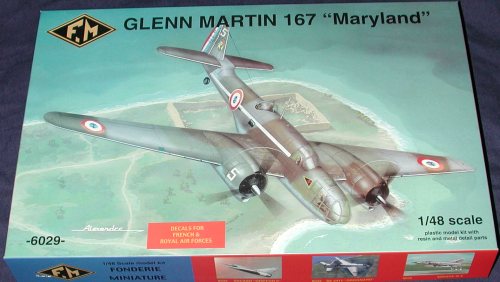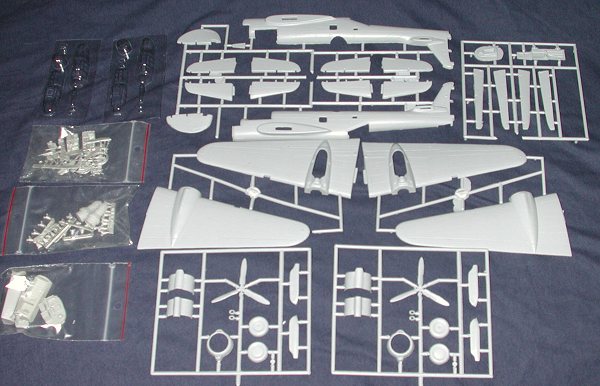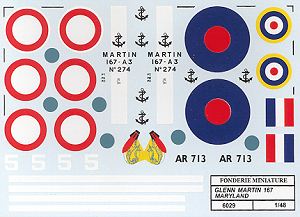
|
KIT: |
F.M. 1/48 Martin 167 Maryland |
|
KIT # |
6029 |
|
PRICE: |
$74.95 ($69.97 from Squadron) |
|
DECALS: |
Two options |
|
REVIEWER: |
Scott Van Aken |
|
NOTES: |
Short run mulitmedia kit. |

|
HISTORY |
Four Groups were equipped with the 'Glenn' and made their first sorties against the invading Germans in May of 1940 on the Northern Front. Heavy losses were experienced, mostly to flak. With Italy's entrance in the war, bombers were transferred south where they were in Vichy territory after the signing of the armistice with Germany. These aircraft were used against Free French and British forces. Some aircraft were used by the Free French forces as well and as late as 1944 were used against German strong points on the Atlantic coast.
The Maryland was also used by the British from those planes not yet delivered to the French. They mostly operated in the Mediterranean and other areas where resistance was not as strong as in Northern Europe. New build Marylands also joined those ex-French aircraft and were widely used against the Africa Corps and other Axis forces in North Africa and the Middle East.
|
THE KIT |

Upon opening the box, one is greeted by a mass of multi-media bits and pieces. Starting with the easy stuff, there are two sets of vacuformed canopies/turrets, each a bit different. Good thing, too as some of the clear bits were a tad deformed and unfortunately, both of my turret bits were creased, mostly because the plastic on the top is very thin. Next is a bag with two engines in it. Each R-1830 engine is built as a kit in itself and consists of a superbly detailed resin block with separate metal cylinders. The sprue for the cylinders has "front" or "rear" on it so you won't get them in backwards! Next is a bag of resin containing the two wheel wells, two seats and the bombardier's aft bulkhead. Again, the resin is superbly done.
Next up is a bag just chock full of metal parts. These include landing gear, instrument panels, guns, radio masts, instrument panel, side walls for the cockpit, control columns, flap and aileron actuating hinges and more smaller pieces. Unfortunately, most show signs of slight mold shift so will not only need clean-up, but care needs to be taken to keep the round pieces round.
The rest of the kit is injected plastic. F.M. seems to have gotten the molds smoother this time as that heavily pebbled surface that plagued previous kits is no longer there. I'm very glad that they have seen fit to take care of that as it now makes the kits so much more 'buildable'. Detailing is a bit soft in some areas, so that hasn't changed much, but it isn't bad at all. The panel lines are a bit of a mixture in that they are nice and distinct in some areas of the kit and almost disappear in others. This means that the builder will need to go over them all to make them uniform. Even though the plastic is a bit thick in places, the only spots I found any sink areas were at the wing roots on the wing halves and the underside of the cockpit floor. All of the plastic parts have varying amounts of flash that will need to be cleaned up. The elevators and rudder are separate and separate ailerons are provided, though the wings have them and the flaps integral to the mold. Apparently it was initially designed to have the separate and something happened when doing the flaps that changed the designer's mind.
Instructions are on two folded sheets of paper. Half of that space is
given to the four construction steps, one page to camo
 and decal placement and
one page to history in English and French. No color information is
provided for any of the interior parts of the aircraft, though all the
parts are named. Construction stages are simply exploded diagrams and are
adequate to the task of getting the model together. Markings are provided
for two planes. One is the box art aircraft from Escadrille7B in Syria
during 1941 and is in early Vichy markings. The other is an RAF Maryland
I of 69 Squadron in Malta during 1941 and in a semi-European scheme of
Dark Green/Dark Earth over Sky Blue. Decals are fairly well printed,
though it seems that the red is a bit off register in the main upper wing
roundels as I can see some white leaking through the edges of the red.
The printers totally hosed the French unit badges so substitutes are
provided on a small addendum sheet. The builder will need to paint the
red and blue rudder stripes for the French aircraft.
and decal placement and
one page to history in English and French. No color information is
provided for any of the interior parts of the aircraft, though all the
parts are named. Construction stages are simply exploded diagrams and are
adequate to the task of getting the model together. Markings are provided
for two planes. One is the box art aircraft from Escadrille7B in Syria
during 1941 and is in early Vichy markings. The other is an RAF Maryland
I of 69 Squadron in Malta during 1941 and in a semi-European scheme of
Dark Green/Dark Earth over Sky Blue. Decals are fairly well printed,
though it seems that the red is a bit off register in the main upper wing
roundels as I can see some white leaking through the edges of the red.
The printers totally hosed the French unit badges so substitutes are
provided on a small addendum sheet. The builder will need to paint the
red and blue rudder stripes for the French aircraft.
|
CONCLUSIONS |
On first look, it appears that F.M. is moving slowly upwards in the quality of its kits. The subject is one that is interesting to many modelers and has previously only been available in this scale by the Koster vacuform kit. Despite the fact that I know this will undoubtedly end up being a challenge to build, I look forward to giving it a try.
|
REFERENCES |
If you would like your product reviewed fairly and quickly by a site that has nearly 250,000 visitors a month, please contact me or see other details in the Note to Contributors.